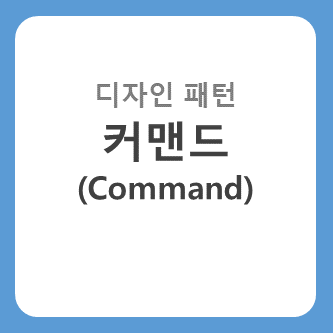
커맨드 패턴은 요청을 개체의 형태로 캡슐화 하여 요청에 필요한 모든 정보를 포함시킨다. 이를 통해 큐에 저장하거나 로그로 남기거나 실행 취소 할 수 있는 기능을 제공 할 수 있다. 커맨드 패턴을 사용하면 실행될 기능을 매개변수화 할 수 있으며 요청을 개체로 캡슐화 함으로써 실행할 작업을 독립적으로 관리할 수 있다.
주요 개념 부터 알아보자
1. Command 인터페이스 : 실행할 작업을 정의한다.
2. ConcreateCommand 클래스 : Command 인터페이스를 구현하고, 실제 실행할 작업을 정의 한다.
3. Invoker 클래스 : Command 개체를 실행한다.
4. Receiver 클래스 : 실제로 작업을 수행하는 개체이다.
5. Client 클래스 : Command 개체를 생성하고, Invoker와 Receiver 개체를 설정한다.
예시 소스코드로 텍스트 편집기 기능을 구현해보자
Command Interface
// Command 인터페이스: 실행할 작업을 정의
interface Command {
void execute();
void undo();
}
Receiver Class
// TextEditor 클래스: 실제 작업을 수행하는 클래스 (Receiver)
class TextEditor {
private StringBuilder text = new StringBuilder();
public void write(String str) {
text.append(str);
}
public void erase(int length) {
text.delete(text.length() - length, text.length());
}
public String getText() {
return text.toString();
}
}
ConcreteCommand Class
// WriteCommand 클래스: 텍스트 작성 명령
class WriteCommand implements Command {
private TextEditor editor;
private String text;
public WriteCommand(TextEditor editor, String text) {
this.editor = editor;
this.text = text;
}
@Override
public void execute() {
editor.write(text);
}
@Override
public void undo() {
editor.erase(text.length());
}
}
Invoker Class
import java.util.Stack;
// CommandInvoker 클래스: 명령을 실행하고 실행 취소하는 클래스
class CommandInvoker {
private Stack<Command> commandHistory = new Stack<>();
public void executeCommand(Command command) {
command.execute();
commandHistory.push(command);
}
public void undoLastCommand() {
if (!commandHistory.isEmpty()) {
Command command = commandHistory.pop();
command.undo();
}
}
}
Client Class
// Client 클래스: Command 객체를 생성하고 Invoker와 Receiver 객체를 설정
public class CommandPatternDemo {
public static void main(String[] args) {
TextEditor editor = new TextEditor();
CommandInvoker invoker = new CommandInvoker();
Command writeHello = new WriteCommand(editor, "Hello, ");
Command writeWorld = new WriteCommand(editor, "world!");
invoker.executeCommand(writeHello);
invoker.executeCommand(writeWorld);
System.out.println("Text after writes: " + editor.getText());
invoker.undoLastCommand();
System.out.println("Text after undo: " + editor.getText());
invoker.undoLastCommand();
System.out.println("Text after second undo: " + editor.getText());
}
}
출력
//출력
//Text after writes: Hello, world!
//Text after undo: Hello,
//Text after second undo:
Command Interface에서 execute와 undo 메서드를 정의했다.
ConcreteCommand Class 에서는 Command 인터페이스를 구현하고, execute와 undo 메서드를 통해 작업을 실행하고 취소한다.
Invoker Class ㄴ는 명령을 실행하고 실행 취소 할 수 있는 클래스로 명령의 실행과 취소를 관리한다.
Receiver Class 는 실제 작어블 수행하는 클래스이다.
Client Class 는 Command 개체를 생성하고, Invoker와 Receiver 개체를 설정하여 명령을 실행한다.
이와같이 실무에서도 실행 취소 기능이나 큐 등으로 활용할때 커맨드 패턴을 사용한다.
'Design Pattern > 행동 패턴(Behavioral Patterns)' 카테고리의 다른 글
| 메멘토(Memento) - 행동 패턴(Behavioral Patterns) (0) | 2024.05.25 |
|---|---|
| 중재자(Mediator) - 행동 패턴(Behavioral Patterns) (0) | 2024.05.25 |
| 반복자(Iterator) - 행동 패턴(Behavioral Patterns) (0) | 2024.05.25 |
| 인터프리터(Interpreter) - 행동 패턴(Behavioral Patterns) (0) | 2024.05.25 |
| 책임 연쇄(Chain of Responsibility) - 행동 패턴(Behavioral Patterns) (0) | 2024.05.25 |



